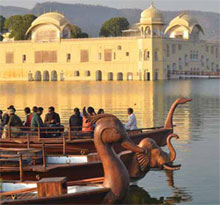

Jaipur’s Jal Mahal is restored to magnificence through prudent use of the city’s wastewater
By Apoorva Bhatia, Jaipur
The very heart of Jaipur lies in its history. Although there is plenty of evidence of thoughtful architecture, one monument still stands out – the Jal Mahal, also called the Jewel of Jaipur, which sits in the middle of the Mansagar Lake.
The Mansagar lake may now fascinate the beholder, but it has seen the most terrible times in the recent past. For decades, it has received the cityʼs sewage channeled through the Brahmpuri and Nagatalai Nallahs. By 2000, the lake looked like an excavated ground used as a dumping site for the cityʼs wastes. The natural water had dried up completely and all that remained was a stench as a result of years of sedimentation of the untreated wastes. With no sign of water or life, the lake ceased to exist by 2005.

Photo: Showvik Das Tamal
Since the 1990s, the government made many efforts to restore the lost lake, but all ended in vain. In 2002, the government floated the proposal to rope in private players to develop the lake through a PPP (public private partnership) mode. This attracted several private hoteliers, but all backed out when they discovered the high investments needed to bring the lake to life. Finally, Jal Mahal Resorts Pvt Ltd (JMRPL) entered into a partnership with the government and took much awaited revival measures.
The two nallahs were bypassed to prevent untreated sewerage from flowing directly into the lake. This sewage is now channeled downstream, treated partially and used for irrigation.
Only stormwater now enters the lake. But as stormwater is inevitably contaminated with the sewage from colonies unconnected to the cityʼs sewage network, the project set up an in-situ settling basin with sedimentation tanks to reduce suspended solids. Only the overflow from the sedimentation tank is allowed to enter the lake.
New species of aquatic vegetation were introduced from the Bharatpur wetlands. Eight earthen islands were created using the dredged silt, and planted with vegetation to serve as habitats for resident and migratory bird species.
The results have been impressive, with project reports showing a dramatic decrease in both the biological oxygen demand and chemical oxygen demand (BOD and COD) to 11-21 and 65-90 respectively.
The deal with JMRPL involved the transfer of 100 acres land to the company on a 99-year lease, for which the company pays Rs. 3 crore each month. The floor space index, or the propotion of total built up area has been kept to a low 0.13, to prevent the area from becoming a concrete jungle.

Photo: Subash Karki
However, today, after JMRPL invested heavily to restore the palace, the privatization of the restoration project has been challenged in the courts.
Allegations have been made of the promoters fixing the tendering process to win the bids. Promoters on their part insist that they won the project bids fairly, and that they have already spent upwards of Rs, 50 crore in restoring the lake and the palace.
The walls are adorned with miniature inspired frescoes. The terrace gardens, Chameli Bagh, has been restored in the style of the classic char bagh mughal style, with water ways and marble fountainery lit up from beneath by the latest LED lighting.
However, the legal wrangles have put a stop to all construction activities on the leased land. The site is open to visits by special invitation only.



